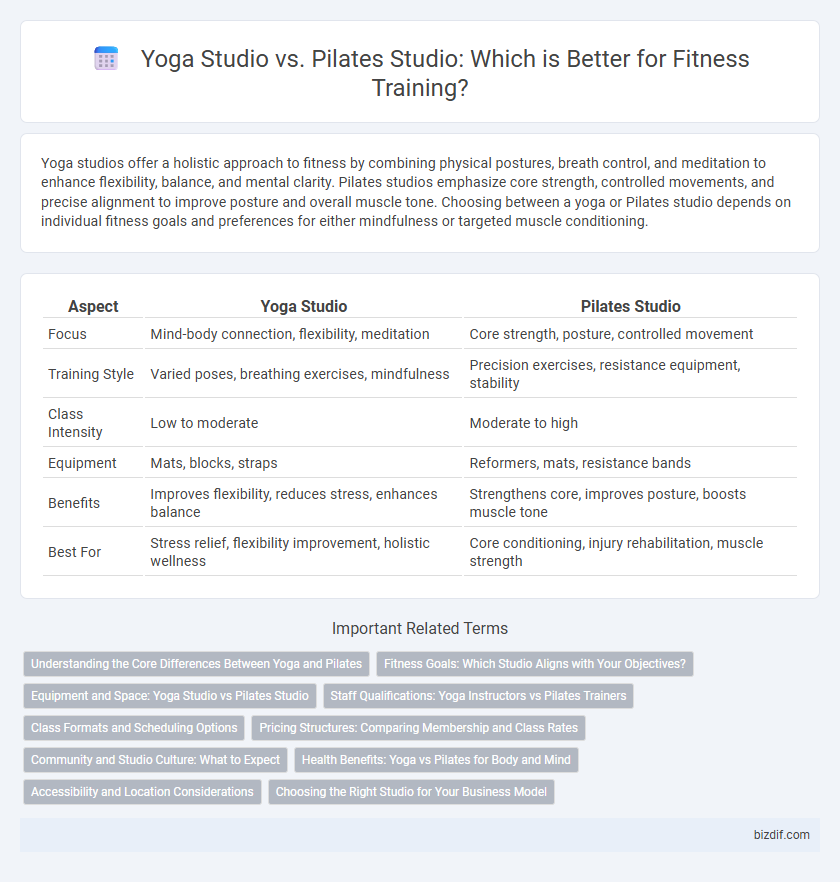Yoga studios offer a holistic approach to fitness by combining physical postures, breath control, and meditation to enhance flexibility, balance, and mental clarity. Pilates studios emphasize core strength, controlled movements, and precise alignment to improve posture and overall muscle tone. Choosing between a yoga or Pilates studio depends on individual fitness goals and preferences for either mindfulness or targeted muscle conditioning.
Table of Comparison
| Aspect | Yoga Studio | Pilates Studio |
|---|---|---|
| Focus | Mind-body connection, flexibility, meditation | Core strength, posture, controlled movement |
| Training Style | Varied poses, breathing exercises, mindfulness | Precision exercises, resistance equipment, stability |
| Class Intensity | Low to moderate | Moderate to high |
| Equipment | Mats, blocks, straps | Reformers, mats, resistance bands |
| Benefits | Improves flexibility, reduces stress, enhances balance | Strengthens core, improves posture, boosts muscle tone |
| Best For | Stress relief, flexibility improvement, holistic wellness | Core conditioning, injury rehabilitation, muscle strength |
Understanding the Core Differences Between Yoga and Pilates
Yoga studios emphasize flexibility, mindfulness, and breath control through a variety of postures aimed at enhancing mental and physical balance. Pilates studios focus primarily on strengthening the core muscles, improving posture, and enhancing overall body alignment through controlled, precise movements. Both practices offer unique benefits, with yoga integrating spiritual elements and Pilates targeting muscle endurance and rehabilitation.
Fitness Goals: Which Studio Aligns with Your Objectives?
Yoga studios emphasize flexibility, balance, and mental relaxation, making them ideal for stress reduction, improved posture, and overall body awareness. Pilates studios focus on core strength, muscle toning, and injury rehabilitation, aligning well with goals of enhanced muscular endurance and physical rehabilitation. Choosing between the two depends on whether your fitness objectives prioritize holistic mindfulness and flexibility or targeted strength and stability development.
Equipment and Space: Yoga Studio vs Pilates Studio
Yoga studios typically emphasize open, spacious areas with minimal equipment, primarily using mats, blocks, and straps to enhance flexibility and balance exercises. Pilates studios are more equipped, featuring specialized machines such as the Reformer, Cadillac, and Chair, designed to provide resistance training and support controlled movements. The distinct spatial arrangements reflect each discipline's focus: yoga prioritizes fluid motion and breathing in an uncluttered environment, while Pilates studios maximize functional equipment for precision and strength development.
Staff Qualifications: Yoga Instructors vs Pilates Trainers
Yoga instructors typically hold certifications from accredited organizations such as the Yoga Alliance, emphasizing holistic mind-body practices and extensive training in breath control, meditation, and various yoga styles. Pilates trainers often possess certifications from recognized bodies like the Pilates Method Alliance, with specialized knowledge in biomechanics, core stabilization, and equipment-based exercises such as reformer Pilates. Both staff qualifications ensure safety and effectiveness, but yoga instructors focus more on spiritual and flexibility training while Pilates trainers prioritize core strength and rehabilitation techniques.
Class Formats and Scheduling Options
Yoga studios typically offer a variety of class formats including Vinyasa, Hatha, and Restorative yoga, catering to different skill levels and fitness goals; classes often range from 45 to 90 minutes. Pilates studios focus on reformer, mat, and clinical Pilates formats targeting core strength and flexibility, with sessions usually lasting 50 to 60 minutes. Scheduling options at yoga studios are often more flexible, featuring drop-in classes, workshops, and multi-level sessions throughout the day, while Pilates studios tend to have structured class times and may emphasize small group or private sessions for personalized instruction.
Pricing Structures: Comparing Membership and Class Rates
Yoga studios typically offer tiered membership plans with monthly fees ranging from $50 to $150, while Pilates studios often charge higher rates, between $70 and $200 per month, reflecting specialized equipment costs. Drop-in class prices at yoga studios average $15 to $25, whereas Pilates classes can cost $30 to $50 per session due to personalized instruction and use of reformer machines. Package deals and class bundles are common in both, but Pilates studios usually provide fewer discounts compared to yoga studios, emphasizing premium pricing strategies.
Community and Studio Culture: What to Expect
Yoga studios often emphasize a holistic community atmosphere centered around mindfulness, meditation, and spiritual growth, fostering strong bonds among practitioners through shared rituals and group sessions. Pilates studios typically focus on a more structured, fitness-oriented environment with personalized guidance, promoting a culture of physical improvement and technical precision. Expect a yoga studio culture to prioritize emotional connection and communal support, while Pilates studios cultivate a goal-driven, performance-based community.
Health Benefits: Yoga vs Pilates for Body and Mind
Yoga studios emphasize flexibility, stress reduction, and mental clarity through breath control and diverse postures, offering holistic benefits for the mind and body. Pilates studios focus on core strength, muscle toning, and posture alignment, enhancing physical stability and injury prevention. Both practices improve overall health, with yoga prioritizing mindfulness and relaxation, while Pilates targets muscular endurance and functional movement.
Accessibility and Location Considerations
Yoga studios often prioritize central, urban locations to enhance accessibility for diverse clientele, offering flexible class schedules to accommodate busy lifestyles. Pilates studios, while increasingly widespread, may be situated in more specialized fitness centers or suburban areas, emphasizing personalized attention and equipment availability. Both types of studios typically assess public transportation links, parking facilities, and ADA compliance to ensure inclusivity and convenience for all participants.
Choosing the Right Studio for Your Business Model
Choosing the right studio for your business model depends heavily on your target clientele and the types of classes you want to offer. Yoga studios typically attract clients seeking mindfulness, flexibility, and stress reduction, while Pilates studios focus on core strength, rehabilitation, and precise body control. Evaluating market demand, instructor expertise, and equipment investment will optimize your business's operational strategy and growth potential.
Yoga Studio vs Pilates Studio Infographic

 bizdif.com
bizdif.com